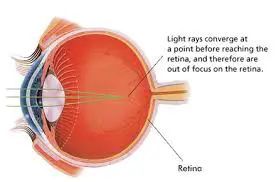Myopia Ayurvedic Treatment
Myopia Ayurveda treatment in Odisha is possible at Astang Ayurveda,  Bhubaneswar. This non surgical non invasive treatment is achieved by Ayurveda Panchakarma Treatment and Ayurvedic herbal medicine. The specialized Myopia Ayurvedic treatment is conducted by our well known eye specialist Dr Prasant Kumar Sahoo.
Bhubaneswar. This non surgical non invasive treatment is achieved by Ayurveda Panchakarma Treatment and Ayurvedic herbal medicine. The specialized Myopia Ayurvedic treatment is conducted by our well known eye specialist Dr Prasant Kumar Sahoo.
What is Myopia
This is commonly known as shortsightedness, which means poor vision for distance. It happens when the eye ball size increases or increase in curvature of cornea or lens. In myopia the light rays from the visual object falls in front of retina instead of falling on retina. Increase in refractive index of lens or excessive use of accommodation e.g. excessive use of near work like use of computers and smart phones are other causes.
Types of Myopia
Congenital mayopia: This occurs since birth, usually with high degree of error, about 8D to 10D. Simple or developmental myopia: this is most common variety. It is considered as a physiological error not associated with any disease of eye. Mostly occurs in school going age of children, so it is also called as School myopia. Pathological or degenerative myopia: it is also known as degenerative or progressive myopia which starts from childhood and progresses rapidly with degenerative changes in retina. Acquired myopia: In case of hardness of nucleus of lens (nuclear sclerosis) progressive myopia occurs, and in case of curvatural myopia the corneal curvature increases like in Keratoconus (conical cornea). Poor vision for distance, head ache and half shunting of eyes are most common symptoms which occur in myopia.
Myopia Treatment
Optical Treatment of Myopia: Corrected by prescription of minus power lenses, so that clear image is formed on the retina. Surgical treatment of myopia: Radial keratotomies, lamellar keratotomy, Laser in situ keraomileusis (LASIK) are procedures, which are current available surgical methods for myopia correction.
Drawbacks in modern medicine
Apart from spectacle correction other surgical methods involve high risk and require high cost of the sophisticated surgical methods. Affordability and patient compliance are other draw backs of modern therapeutics for myopia correction. In contrast, Ayurveda provides holistic approach/procedures to correct myopia through Kriyakalpa and Panchakarma procedures.
Myopia and Ayurveda Concept
Myopia in Ayurveda is well described by Sushruta under Drishtigata Vyadhi. There are four Patalas or tunics in internal eye ball. When the vitiated dosha resides in 2nd or 3rdpatala of eye ball, the vision for distance is disturbed and manifests as Timir or Myopia.
Myopia Ayurvedic Treatment
Myopia or Timir management in Ayurveda includes Vata Shamak Chikitsa with Chakshyushya drugs. The best treatment for myopia includes Snehapana, Virechana, Nasya, NetraTarpana, Basti Karma, Padaabhyanga and Eye exercise. Saptamrita Lauha, Mahatriphala Ghrit, Jeevantyadi ghrit are important medications which enhances the healing of the visual media. As corneal surface and tonicity of extra ocular muscles and size of eye ball are significant factors which determines the power of myopia. Eye exercise significantly improves the myopia correction. Corneal flattening or correction of corneal curvature through Tarpan, Pindi, Nasya, and Vidalaka are more safeand cost effective than modern surgical methods. Unlike modern medicine, Ayurveda treats myopia with age old proven methods, which not only corrects visual media but also improves nutrition to the tunics or layers of eye ball. Yoga procedures like Tratak, Bhramari kriya too has role in improving vision in myopic cases. Diet rich in vitamins, proteins and management of other debilitating diseases are part of myopia management through ayurveda.
Myopia Ayurvedic Treatment at Astang Ayurveda, Bhubaneswar
At Astang Ayurveda we successfully treat myopia with aiming to reduce the lens power and as well to improve quality of vision with authentic Ayurveda Panchakarma, Kriyakalpa procedures and time tested Ayurvedic medicine by our Ayurvedic Eye specialist doctors.
Written by: Dr Prasanta Kumar Sahoo
Email ID: sahooprasanta78@gmail.com
For Eyes treatment, you can Contact our Astang Ayurveda hospital at Bhubaneswar, India.
For inquiry, Call us;
or Mail us;
Get Directions to Our Location on the Map
o Congenital myopia (present at birth),
o Simple or developmental myopia (common in children),
o Pathological or degenerative myopia (progressive and associated with retinal changes),
o Acquired myopia (due to changes in the lens or cornea).
